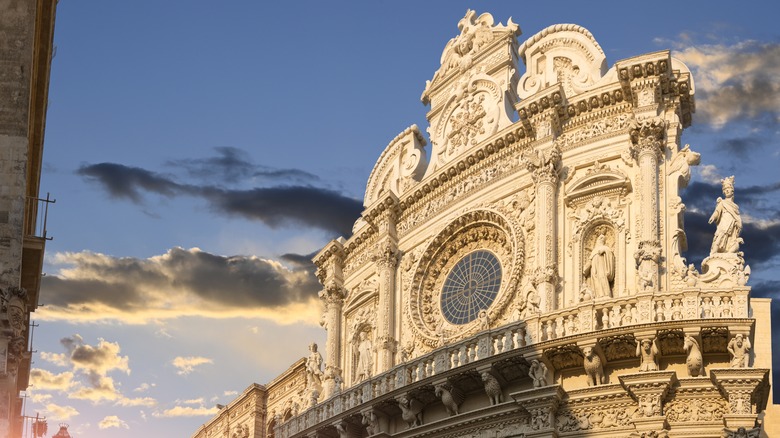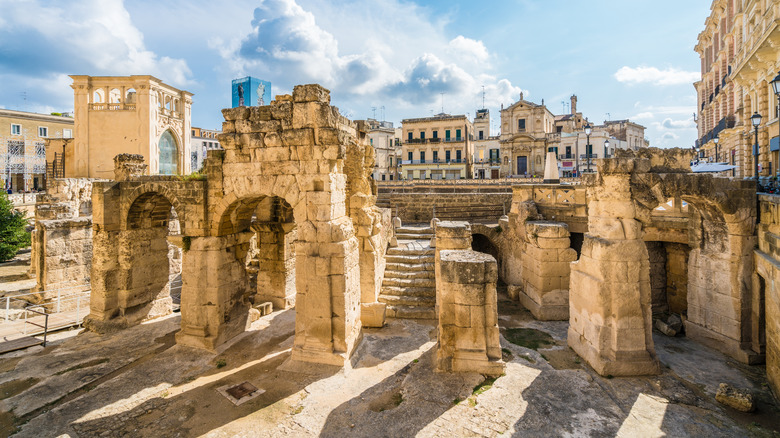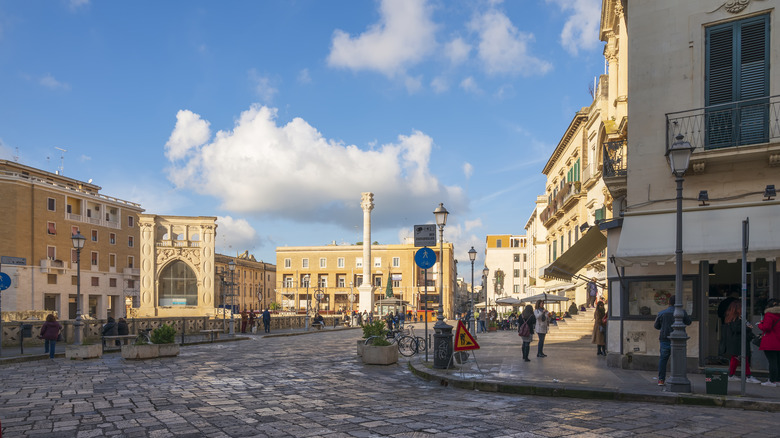This Romantic, Hidden Gem City In Italy Feels Like A Step Back In Time
Italy is known for its history (and its food, of course). There are remains all over the former center of the Roman Empire that are masterpieces of architecture, like Roman roads, amphitheaters, buildings, and temples. As time moved along, we got even more spectacular structures and decorations. Some places like Rome have captured the bustling feel of a modern city while showing off its millennia-long habitation. Others, like the hidden Italian gem Lecce, make it feel like you've traveled through time to visit a different era. Well, several different eras.
Located in the southern region of Puglia, this romantic city sits right on the heel of the Italian "boot." Not only does it have some impressive Roman and even pre-Roman ruins to visit, but it's a Baroque masterpiece. If you have ever wanted to see stunning buildings that look like a fancy wedding cake, Lecce is your place. Its distinctive golden and cream limestone used for so many of the buildings is called "pietra leccese," or "Lecce stone." Add in the incredible food and the underground ruins found in a private home, and you have the perfect trip back to the days of yore.
Visiting the past in Lecce, Italy
Lecce isn't a tourist hotspot like Florence or Rome, and it's a good idea to do a little work on your Italian and not assume everyone speaks English there. (You should also consider taking advantage of the Google Translate app, which lets you use your camera to translate signs and packaging.) This will better enable you to engage with the locals and the city's long history. The Romans took over Lecce in the third century BCE (when it was called Licea) and shifted the town's location a bit. Emperor Hadrian fortified it and built a Roman road from Lecce to the coast. The Byzantine Empire later controlled it, followed by the Normans.
A trip to the Roman amphitheater, built at the end of the second century AD, in the main part of the city (pictured above) is a must-do. The entire site hasn't been excavated yet, but what has been is incredible. It wasn't even found until 1929! The place would have held around 25,000 people when it was functioning. You can get another glimpse of Lecce's rich past by visiting the Museo Faggiano. During work on the sewage system of a private home, 2,500-year-old ruins with tombs, escape holes, and more were found. The Knights Templar used this place between 1000 and 1200, and then it was a convent until 1600, but the history goes back to pre-Roman times. Then visit the Museo Ebraico, or Jewish Museum, which tells the history of the Jewish community that lived there in the Middle Ages until they were forced from the city in 1540.
Breathtaking views and delicious food
This city town has a maze of little streets to walk through and the main square, Piazza Sant'Oronzo (pictured above). That's where you'll find the Basilica di Santa Croce, which has incredible Baroque carvings. It dates back to the height of the Baroque movement, and Lecce embraced it wholeheartedly, as you'll see during your time there. You can visit the Duomo di Lecce, or Lecce Cathedral, from 1144 (rebuilt in 1659) and climb its famous bell tower for a view. One such view is the Porta Napoli, an impressive arch that originally functioned as the gate of the city walls. You can also visit the Castello di Carlo V, a.k.a. the castle of Charles V, the Holy Roman Emperor and King of Spain. He had its towers built to keep out the Ottoman army in the mid-16th century. It's now a spot for cultural events.
The city itself is full of artisan shops and restaurants where you should try the caffè leccesse, a coffee shot with almond syrup and ice, or cozze gratinate, which is mussels with parmesan. You cannot miss the gelato and the local wine and olive oil. If you want a break or if you're traveling with kids, visit the Giardini Pubblici Giuseppe Garibaldi, a public park with fountains and plenty of trees, and its Parco Giochi, a playground for the little ones. If you visit in August, you can experience the Luminaire Light Festival, with light decorations hung over wooden frames all around the city.


